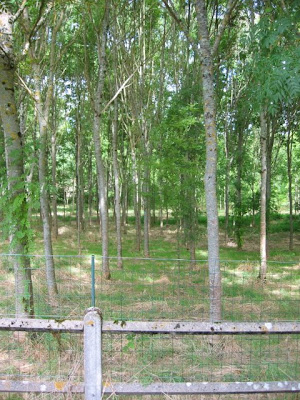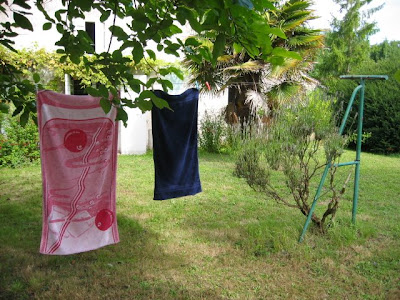
Inspired by Catherine Karnow and by Joyce DiDonato, who take wonderful pictures of everything they see, and by Martha Strecker, who always wants to know what the flowers are like when friends travel abroad, I took a few snaps of the more notable vegetation around l’Enclouze, the Boutrits’ country home outside Royan, during my visit last month. Thereafter, I promptly forgot all about the pictures, and though they’re not as good as what Cathy or Joyce would’ve managed, I came across them at last and am sharing them now, to give you a little idea of my surroundings in a place that’s dear to me.
 Henri Boutrit’s beech grove (hêtraie), a mournful spot in December, is cool and shady in summer. It’s bordered by hedges and by numerous blackberry brambles. In season, it’s worth trying to pick some, if you don’t mind wading through the grass, which falls where it is mown and turns to a deep carpet of straw that obscures treacherous furrows, potholes, and the occasional garter snake. The grove is also inhabited by stinging nettles (orties), about which more will be seen. The summer has been wet and cool, and the blackberries weren’t ripe yet.
Henri Boutrit’s beech grove (hêtraie), a mournful spot in December, is cool and shady in summer. It’s bordered by hedges and by numerous blackberry brambles. In season, it’s worth trying to pick some, if you don’t mind wading through the grass, which falls where it is mown and turns to a deep carpet of straw that obscures treacherous furrows, potholes, and the occasional garter snake. The grove is also inhabited by stinging nettles (orties), about which more will be seen. The summer has been wet and cool, and the blackberries weren’t ripe yet.
 Closer to the house are several fuchsia bushes, in breathtaking bloom in mid-August. Martine picked a bouquet of them that waited in a vase to greet us when we arrived. Apparently, the French call them fuchsia, too — go figure.
Closer to the house are several fuchsia bushes, in breathtaking bloom in mid-August. Martine picked a bouquet of them that waited in a vase to greet us when we arrived. Apparently, the French call them fuchsia, too — go figure.
 The old lavender bush (lavande) in the yard has seen better days: it’s a bit scraggly now, but its fragrance remains sweet. The Boutrits planted the clothesline next to it, so that our drying beach towels smell quite wonderful. The towels didn’t have much occasion to get wet, I’m afraid. We did manage a trip to the beach this trip, during a fleeting interval between rainstorms. The water was cold, the wind colder, the combination unbearable — but it wouldn’t be summer without going for a swim at least once. I did my duty, in a hurry.
The old lavender bush (lavande) in the yard has seen better days: it’s a bit scraggly now, but its fragrance remains sweet. The Boutrits planted the clothesline next to it, so that our drying beach towels smell quite wonderful. The towels didn’t have much occasion to get wet, I’m afraid. We did manage a trip to the beach this trip, during a fleeting interval between rainstorms. The water was cold, the wind colder, the combination unbearable — but it wouldn’t be summer without going for a swim at least once. I did my duty, in a hurry.
 Behind the house is a field of sunflowers (tournesols), all of which turned away from my camera. Perhaps they are shy.
Behind the house is a field of sunflowers (tournesols), all of which turned away from my camera. Perhaps they are shy.
Quite eager to pose are the orties, my principal nemeses in France. Leaves and stems are covered by tiny bristles: touch them, and it’s as if you’ve touched a burning ember. You’ll see the mark and feel the sting for a day, at least.
 Left to their own devices, they grow to great heights over vast spaces, supported by a network of roots that connect them one to another and that drive deep even as they spread wide. If you don’t get the whole root (which in older plants can attain the thickness of a young parsnip, a foot long), the nettle will grow back almost instantly. You must strike early, too, because each plant contains approximately twelve billion tiny seeds, each of which is capable when mature of giving rise to an entire field’s worth of new nettles.
Left to their own devices, they grow to great heights over vast spaces, supported by a network of roots that connect them one to another and that drive deep even as they spread wide. If you don’t get the whole root (which in older plants can attain the thickness of a young parsnip, a foot long), the nettle will grow back almost instantly. You must strike early, too, because each plant contains approximately twelve billion tiny seeds, each of which is capable when mature of giving rise to an entire field’s worth of new nettles.
With a nearly maniacal vengeance, I’ve rid the garden in Beynes of them over the years, but l’Enclouze is a farm and therefore hopeless. If I see any nettles near the house, I uproot them, but that’s the best I can do. Even that modest effort is futile, because nettles from other nearby fields will always be contaminating us. Soon the nation of France will be entirely consumed by them.
 In closing, here’s the terrace by the kitchen, with its wishing well and its arbor, created by grapevines (vignes) and those bright-red, waxy-petaled, trumpet-shaped flowers the names of which I don’t know in any language. Though I took this picture last year (when I posted it in this space), the scene remains much the same — and I’m grateful for that.
In closing, here’s the terrace by the kitchen, with its wishing well and its arbor, created by grapevines (vignes) and those bright-red, waxy-petaled, trumpet-shaped flowers the names of which I don’t know in any language. Though I took this picture last year (when I posted it in this space), the scene remains much the same — and I’m grateful for that.
 Henri Boutrit’s beech grove (hêtraie), a mournful spot in December, is cool and shady in summer. It’s bordered by hedges and by numerous blackberry brambles. In season, it’s worth trying to pick some, if you don’t mind wading through the grass, which falls where it is mown and turns to a deep carpet of straw that obscures treacherous furrows, potholes, and the occasional garter snake. The grove is also inhabited by stinging nettles (orties), about which more will be seen. The summer has been wet and cool, and the blackberries weren’t ripe yet.
Henri Boutrit’s beech grove (hêtraie), a mournful spot in December, is cool and shady in summer. It’s bordered by hedges and by numerous blackberry brambles. In season, it’s worth trying to pick some, if you don’t mind wading through the grass, which falls where it is mown and turns to a deep carpet of straw that obscures treacherous furrows, potholes, and the occasional garter snake. The grove is also inhabited by stinging nettles (orties), about which more will be seen. The summer has been wet and cool, and the blackberries weren’t ripe yet. Closer to the house are several fuchsia bushes, in breathtaking bloom in mid-August. Martine picked a bouquet of them that waited in a vase to greet us when we arrived. Apparently, the French call them fuchsia, too — go figure.
Closer to the house are several fuchsia bushes, in breathtaking bloom in mid-August. Martine picked a bouquet of them that waited in a vase to greet us when we arrived. Apparently, the French call them fuchsia, too — go figure. The old lavender bush (lavande) in the yard has seen better days: it’s a bit scraggly now, but its fragrance remains sweet. The Boutrits planted the clothesline next to it, so that our drying beach towels smell quite wonderful. The towels didn’t have much occasion to get wet, I’m afraid. We did manage a trip to the beach this trip, during a fleeting interval between rainstorms. The water was cold, the wind colder, the combination unbearable — but it wouldn’t be summer without going for a swim at least once. I did my duty, in a hurry.
The old lavender bush (lavande) in the yard has seen better days: it’s a bit scraggly now, but its fragrance remains sweet. The Boutrits planted the clothesline next to it, so that our drying beach towels smell quite wonderful. The towels didn’t have much occasion to get wet, I’m afraid. We did manage a trip to the beach this trip, during a fleeting interval between rainstorms. The water was cold, the wind colder, the combination unbearable — but it wouldn’t be summer without going for a swim at least once. I did my duty, in a hurry. Behind the house is a field of sunflowers (tournesols), all of which turned away from my camera. Perhaps they are shy.
Behind the house is a field of sunflowers (tournesols), all of which turned away from my camera. Perhaps they are shy.Quite eager to pose are the orties, my principal nemeses in France. Leaves and stems are covered by tiny bristles: touch them, and it’s as if you’ve touched a burning ember. You’ll see the mark and feel the sting for a day, at least.
 Left to their own devices, they grow to great heights over vast spaces, supported by a network of roots that connect them one to another and that drive deep even as they spread wide. If you don’t get the whole root (which in older plants can attain the thickness of a young parsnip, a foot long), the nettle will grow back almost instantly. You must strike early, too, because each plant contains approximately twelve billion tiny seeds, each of which is capable when mature of giving rise to an entire field’s worth of new nettles.
Left to their own devices, they grow to great heights over vast spaces, supported by a network of roots that connect them one to another and that drive deep even as they spread wide. If you don’t get the whole root (which in older plants can attain the thickness of a young parsnip, a foot long), the nettle will grow back almost instantly. You must strike early, too, because each plant contains approximately twelve billion tiny seeds, each of which is capable when mature of giving rise to an entire field’s worth of new nettles.With a nearly maniacal vengeance, I’ve rid the garden in Beynes of them over the years, but l’Enclouze is a farm and therefore hopeless. If I see any nettles near the house, I uproot them, but that’s the best I can do. Even that modest effort is futile, because nettles from other nearby fields will always be contaminating us. Soon the nation of France will be entirely consumed by them.
 In closing, here’s the terrace by the kitchen, with its wishing well and its arbor, created by grapevines (vignes) and those bright-red, waxy-petaled, trumpet-shaped flowers the names of which I don’t know in any language. Though I took this picture last year (when I posted it in this space), the scene remains much the same — and I’m grateful for that.
In closing, here’s the terrace by the kitchen, with its wishing well and its arbor, created by grapevines (vignes) and those bright-red, waxy-petaled, trumpet-shaped flowers the names of which I don’t know in any language. Though I took this picture last year (when I posted it in this space), the scene remains much the same — and I’m grateful for that.